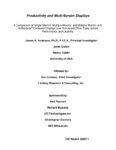TO
Filters: Collection: "ir_eua"
1 - 25 of 7
| Title | Date | Subject | Description | ||
|---|---|---|---|---|---|
| 1 |
 |
The fate of char-N at pulverized coal conditions | 2003 | char-N; pulverized coal conditions; pulverized coal; coal char. | The fate of char-N (nitrogen removed from the coal matrix during char oxidation) has been widely studied at fluidized bed conditions. This work extends the study of char-N to pulverized coal conditions. Coal chars from five parent coals were prepared and burned in a laboratory-scale pulverized coal ... |
| 2 |
 |
User guide for characterizing particulate matter: Evaluation of several real-time methods | 2003 | This User Guide is intended to assist environmental or military personnel who work with air quality measurements, regulations, and planning for the Department of Defense. Specifically, it focuses on an evaluation of three newly developed instruments for characterizing particulate matter (PM), genera... | |
| 3 |
 |
Appendix 1: User guide for characterizing particulate matter | 2003-09 | Air quality; Particulate matter; PM; Characterizing particulate matter; Sampling PM; PM background; Photoacoustic analyzer; PA; Photoelectric Aerosol Sensor; PAS; PAH; Aerosol time-of-flight mass spectrometer; ATOFMS; Dilution and Sampling; Soil; Dust; Smoke; Liquid droplets; Atmosphere; Nitrate; Su... | This User's Guide is intended to assist environmental or military personnel who work with air quality measurements, regulations, and planning for the Department of Defense. Specifically, it focuses on an evaluation of three newly developed instruments for characterizing particulate matter (PM), gene... |
| 4 |
 |
Characterization of particulate emissions: Size fractionation and chemical speciation | 2003-12 | Particulate emissions; Size fractionation; Chemical speciation; DoD emission sources; Aircraft ground support vehicles; Rocket motors; Aircraft; Sandblasting operations; Aerosol time-of-flight mass spectrometer; ATOFMS; Photoelectric aerosol sensor; PAS; Polycyclic aromatic hydrocarbons; PAH; Photoa... | This study developed and validated innovative techniques for characterizing the amount and composition of PM10, PM2.5, and smaller particles for four major classes of DoD emission sources: aircraft ground support vehicles, rocket motors, aircraft, and sandblasting operations. The techniques include ... |
| 5 |
 |
Heavy oil and natural bitumen-strategic petroleum resources | 2003-07 | heavy oil; natural bitumen; strategic petroleum resources; conventional oil; light oil | Because conventional light oil can typically be produced at a high rate and a low cost, it has been used before other types of oil. Thus, conventional oil accounts for a declining share of the Earth's remaining oil endowment. In addition to assessing conventional oil resources, scientists of the U.S... |
| 6 |
 |
Productivity and multi-screen displays | 2003-07-18 | Computer displays; Office productivity | A Comparison of Single Monitor, Multiple Monitor, and Multiple Monitor with Hydravision®Computer Displays over Simulated Office Tasks across Performance and Usability |
| 7 |
 |
Slow radio-frequency processing of large oil shale volumes to produce petroleum-like shale oil | 2003-08-20 | slow radio-frequency processing; large oil shale volumes; petroleum-like shale oil; oil shale | A process is proposed to convert oil shale by radio frequency heating over a period of months to years to create a product similar to natural petroleum. Electrodes would be placed in drill holes, either vertical or horizontal, and a radio frequency chosen so that the penetration depth of the radio w... |
1 - 25 of 7
